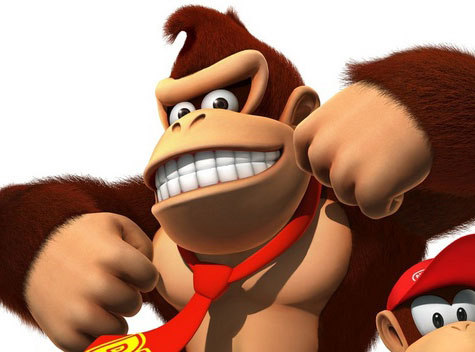Retro dissects Donkey Kong Country Returns
GDC 2011: American developer Retro Studios and Nintendo Japan producer Kensuke Tanabe reminisce about bringing the Kong back to his platforming roots.
Who was there: Retro's GDC talk, titled "Donkey Kong: Swinging Across Oceans," took the form of a panel session. It was chaired by Michael Kelbaugh, president and CEO of the Austin, Texas-based developer, while the panel consisted of Bryan Walker, senior director of development; Aaron Walker, senior engineer; Will Bate, lead animator; Chris Voelmann, technical artist; and Ryan Powell, art lead. It was rounded out by Kensuke Tanabe, Nintendo Co. Ltd. producer and vice president at Retro.

What they talked about:
Once the team started work on the new Donkey Kong, it found it faced a totally new artistic goal over its previous games. "The words we used were 'fun' and 'whimsical'," said Ryan Powell. However, he said, "We'd been making Metroid for 10 years at that point." He claimed that during the design and prototype phase, they'd find that they were still employing old visual aesthetics. "People would say, 'Man, that tree looks like it belongs in Metroid,'" he claimed.
One of the most important moments in development, according to Bryan Walker, was when Retro traveled to Nintendo Japan to meet with Donkey Kong creator Shigeru Miyamoto--or to the "Jedi academy" to meet "Yoda," as he jokingly put it. "We spoke for hours on [the ground pound] feature," he said, claiming that the character's rhythmical pounding didn't feel quite right. "I remember Mr Miyamoto sitting there and playing with it. After a lot of experimentation, and [physically] pounding the table, it became an offset bo-boom, bo-boom. That process of playing with the features, figuring out how to make them fun--overall it improved the quality of the game."
This wasn't the only suggestion that the team took from its visit to Japan. "During an early demo to Mr Miyamoto, he was running left and right, watching how he skidded. He was really close to the monitor, looking at the animations, kicking up dust. He said, 'Looks like DK is blowing--it might be fun to make DK blow on things.' We agreed to give it a shot. The lights didn't instantly come on [back at Retro]--the initial response was 'what the hell.' It was a fun feature [though], and was in line with the fun, whimsical nature of the game."
One feature that wasn't envisaged by Miyamoto was multiplayer, but producer Kensuke Tanabe was very keen on the idea. "The whole multiplayer function was something I pushed for originally," he said. "I actually worked on the localisation of the original Donkey Kong games. You couldn't actually play in multiplayer, and that was something I wanted to see realised. Jungle Beat was also exclusively a one-player game. As you may recall, New Super Mario Bros. Wii had made four-player possible, and seeing that, I had to get multiplayer into Donkey Kong. The directive from Miyamoto was to focus on the single-player experience."
E3 2010 was the first showing for the game, and it was an exciting but nerve-racking time for Retro. "It was just an amazing experience to us, seeing other people playing our game," Kelbaugh explained. "When we got back, we were highly motivated. There was a real boost of development after E3--we were just on fire." Ryan Powell added, "Coming back from E3, it's one of my favourite times. It's fun, but scary. It was very motivating. We could finally see our product coming together. We had four levels. Now we only had to get the other 70 together." Kelbaugh added that he'd heard Nintendo's president was eager to play the game. "Iwata said [to the press], 'I am looking forward to playing this product with my family.' No pressure then."
The team also faced some hurdles during production, including the need to fall in line with Nintendo's development values. Tanabe explained: "Nintendo, at least in the beginning, doesn't focus on making [spec sheets]. Nintendo does things a little bit differently. The idea is to find this key idea to the game that is fun, make a prototype of that, and iterate on that again and again. I remember, this wasn't [Retro's] style at all. Now I think we've come to seeing eye-to-eye in terms of value in game development." Tanabe revealed that the recent Pilotwings Resort was also produced in the US with Minnesota-based development team Monster Games, which previously made Excite Truck for the Wii. "They, much like Retro, have come to understand Nintendo's design philosophy," he said.
Quote: When asked by a member of the audience what other classic Nintendo franchises Retro was interested in working on, members of the panel replied with answers such as: "Doki Doki Panic." "The joke around the office is Pokemon Prime." Kelbaugh added, "We've been looking at Tingle lately. That's a joke."
Takeaway: Donkey Kong Country Returns was a highly collaborative project between Nintendo Japan and Retro Studios in the US. The team had to adapt to making a fun and whimsical platformer after spending 10 years on a shooter franchise. Shigeru Miyamoto made plenty of important suggestions for core gameplay mechanics. And Kensuke Tanabe was insistent on adding multiplayer while bringing Retro in line with Nintendo's development ethos.
Got a news tip or want to contact us directly? Email news@gamespot.com
Join the conversation